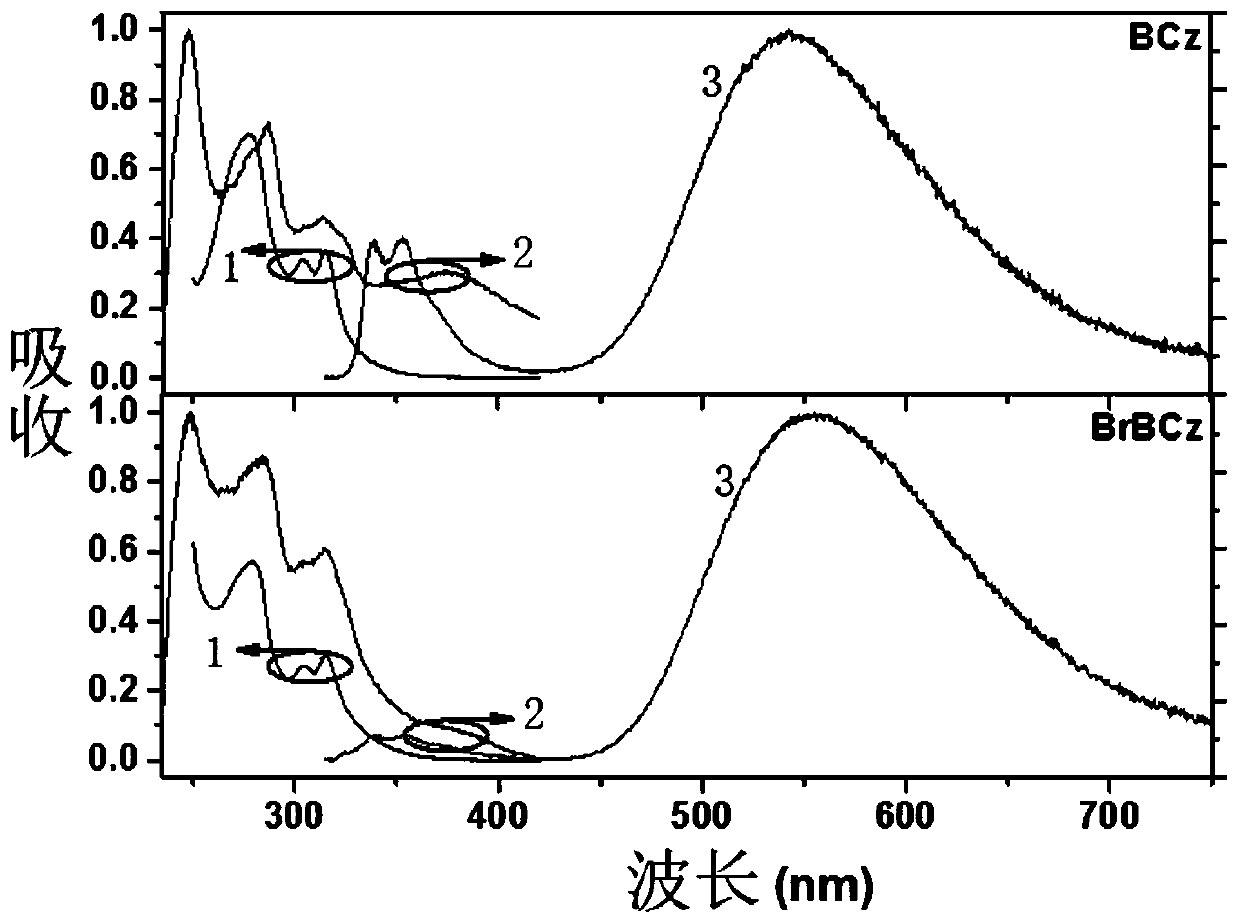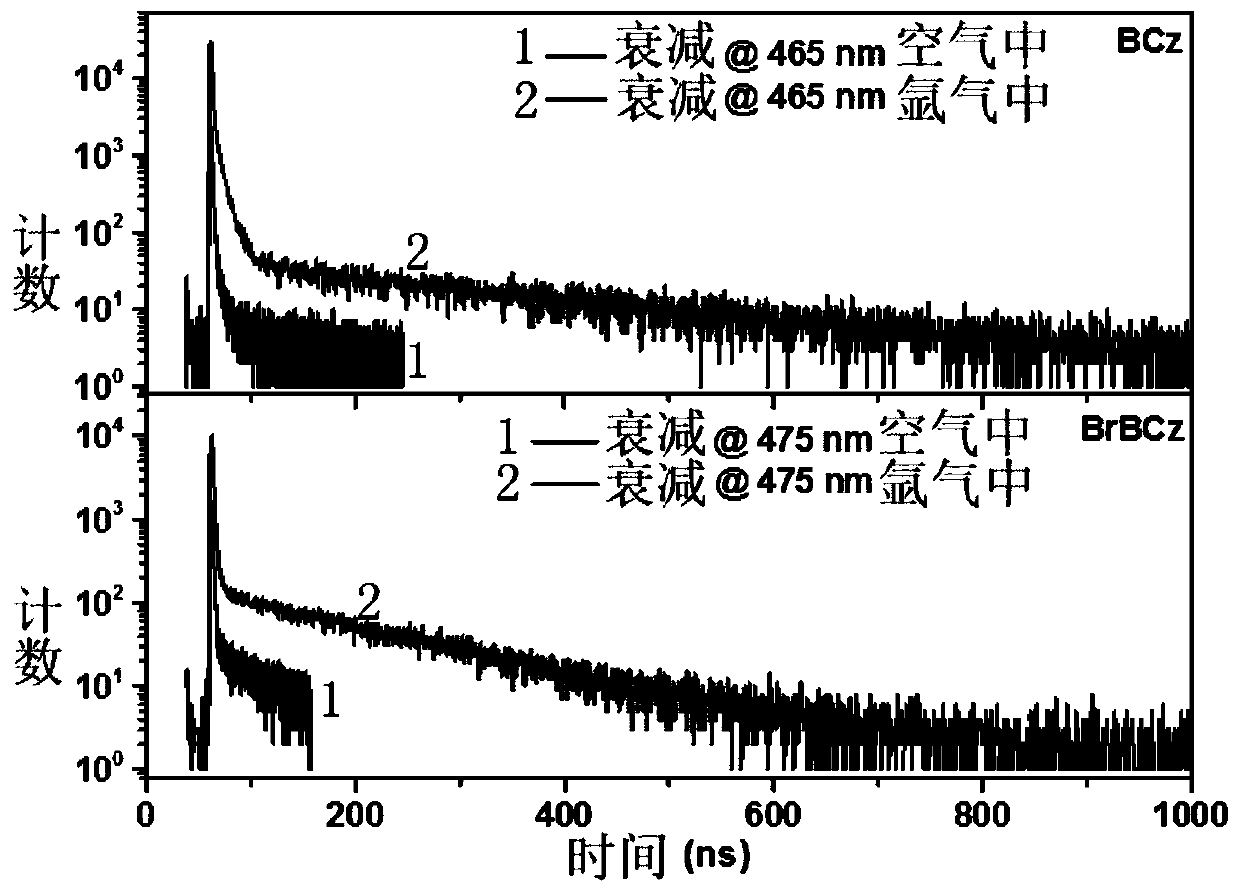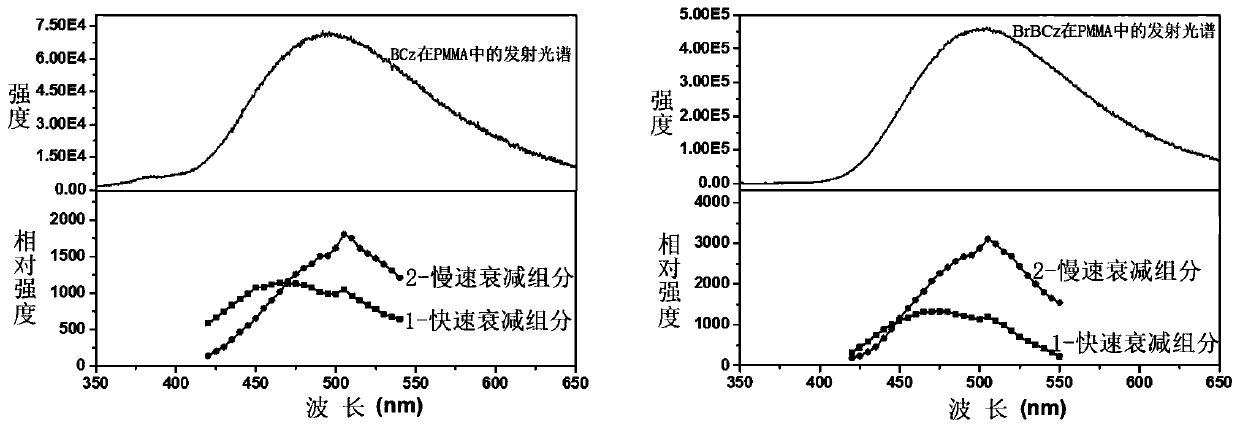TICT (twisted intramolecular charge transfer) triplet-state electroluminescent material and device
A technology of electroluminescent materials and electroluminescent devices, which is applied in the direction of luminescent materials, electric solid devices, semiconductor/solid device manufacturing, etc., and can solve the problems of slow triplet radiation attenuation, power dissipation, and inability to apply organic electroluminescence Devices and other issues, to achieve the effect of improving luminous brightness and external quantum efficiency, and excellent performance
- Summary
- Abstract
- Description
- Claims
- Application Information
AI Technical Summary
Problems solved by technology
Method used
Image
Examples
Embodiment 1
[0056] Embodiment 1 preparation method
[0057] Sodium hydride (0.60 g of a 60% dispersion in mineral oil, 15 mmol) was placed in a 50 mL three-neck round bottom flask connected to a dropping funnel. A solution of carbazole (10 mmol) dissolved in 20 mL of anhydrous tetrahydrofuran (THF) was added to the above dropping funnel. The flask was evacuated and purged three times with nitrogen. Another 5 mL of anhydrous THF was injected into the flask and stirred for 5 minutes. The carbazole solution was then added dropwise over 10 minutes. The reaction mixture was heated to 60°C and stirred for 30 minutes, then cooled to 0°C. While stirring, benzoyl chloride (or its derivative) (12 mmol) was added dropwise to this reaction mixture. The resulting mixture was further heated and stirred at 60°C overnight. After cooling, the product was collected by removing THF in vacuo, dissolved in dichloromethane (DCM), washed three times with water, washed over anhydrous Na 2 SO 4 Dry and pur...
Embodiment 2B
[0068] The photophysical characteristic of embodiment 2BCz and BrBCz
[0069] In dilute solution, several important photophysical properties of BCZ and BRBCZ were measured by UV-Vis absorption and photoluminescence (PL), the results are shown in Table 1 and figure 1 middle. attached figure 1 CH at room temperature for BCZ and BRBCZ 2 Cl 2 Spectra in dilute solution state, where 1 is the UV-Vis absorption spectrum, 2 is the excitation spectrum, and 3 is the emission spectrum. The excitation spectrum is measured at the long-wavelength emission position, and the excitation wavelength of the emission spectrum is 300 nm. Under an argon atmosphere, BCz shows a double emission of benzimide: a long wavelength band at 544 nm and a short wavelength band around 350 nm with a very large Stokes shift (229 nm). Unexpectedly, the PL decay curve monitored at 544 nm revealed two components instead of one to coexist in this broadband ( figure 2 superior). The fitted lifetime of the fast-...
Embodiment 3
[0077] The time-resolved emission spectrum of embodiment 3pBCz, BCz-DMe, BCz, BrBCz
[0078] Under the premise of PL enhancement in PMMA films, time-resolved emission spectroscopy (TRES) can conveniently identify overlapping broadband near 500nm in PMMA films. The pre-exponential values (weighted by the lifetime value) of each attenuation component are plotted against wavelength to generate an attenuation-dependent spectrogram. Both BCz and BrBCz have near 465nm (2.67eV) 1 TICT fluorescence, at 505nm (2.46eV) 3 TICT RTP, such as image 3 shown. From 1 TICT and 3 The emission wavelengths of BCz calculated in the TICT state are 459nm and 569nm, respectively; for BrBCz, they are 470nm and 510nm, respectively. In addition to BCz 3 Except for TICT-RTP wavelength, other values are in good agreement with the experimental results.
[0079]For a deeper understanding of the above based on 3 The RTP mechanism of the TICT state, the inventors specifically verified the stereoc...
PUM
| Property | Measurement | Unit |
|---|---|---|
| thickness | aaaaa | aaaaa |
| thickness | aaaaa | aaaaa |
| thickness | aaaaa | aaaaa |
Abstract
Description
Claims
Application Information
 Login to View More
Login to View More - R&D Engineer
- R&D Manager
- IP Professional
- Industry Leading Data Capabilities
- Powerful AI technology
- Patent DNA Extraction
Browse by: Latest US Patents, China's latest patents, Technical Efficacy Thesaurus, Application Domain, Technology Topic, Popular Technical Reports.
© 2024 PatSnap. All rights reserved.Legal|Privacy policy|Modern Slavery Act Transparency Statement|Sitemap|About US| Contact US: help@patsnap.com










